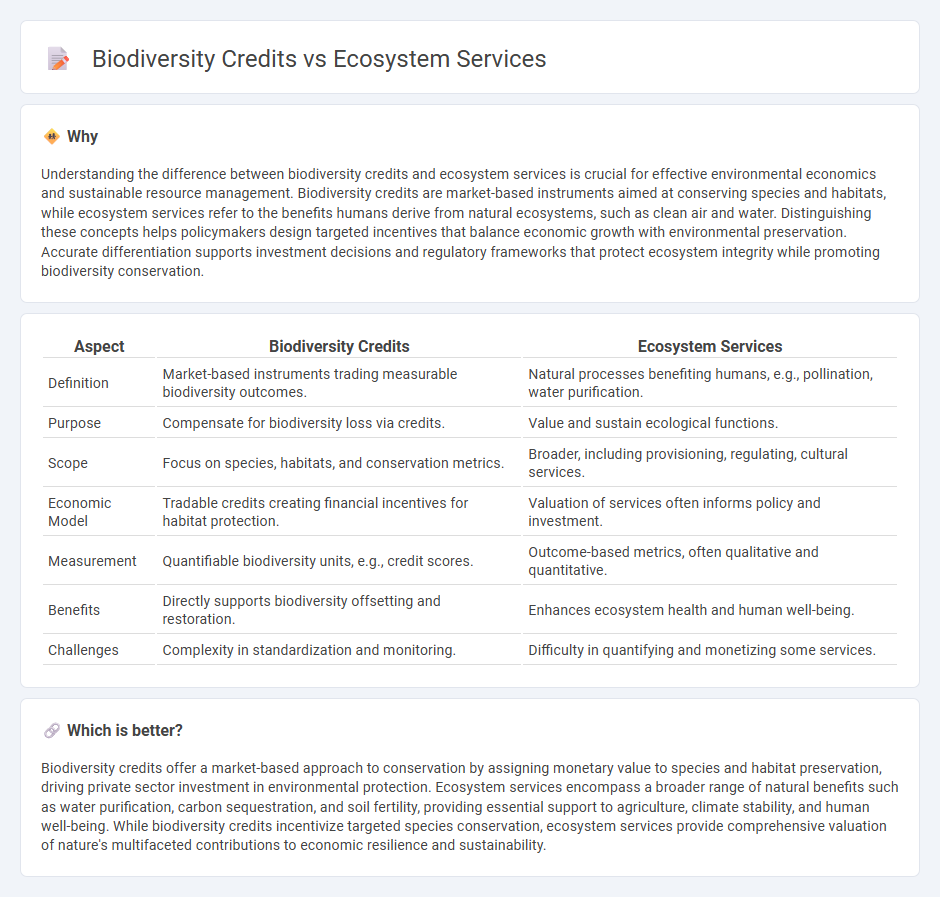
Biodiversity credits represent quantifiable units that measure the preservation or restoration of species and habitats, facilitating market-based conservation efforts. Ecosystem services encompass the broad range of benefits humans derive from natural systems, including water purification, pollination, and carbon sequestration, often valued in economic assessments to guide sustainable resource management. Explore how these concepts drive innovative approaches in environmental finance and policy.
Why it is important
Understanding the difference between biodiversity credits and ecosystem services is crucial for effective environmental economics and sustainable resource management. Biodiversity credits are market-based instruments aimed at conserving species and habitats, while ecosystem services refer to the benefits humans derive from natural ecosystems, such as clean air and water. Distinguishing these concepts helps policymakers design targeted incentives that balance economic growth with environmental preservation. Accurate differentiation supports investment decisions and regulatory frameworks that protect ecosystem integrity while promoting biodiversity conservation.
Comparison Table
| Aspect | Biodiversity Credits | Ecosystem Services |
|---|---|---|
| Definition | Market-based instruments trading measurable biodiversity outcomes. | Natural processes benefiting humans, e.g., pollination, water purification. |
| Purpose | Compensate for biodiversity loss via credits. | Value and sustain ecological functions. |
| Scope | Focus on species, habitats, and conservation metrics. | Broader, including provisioning, regulating, cultural services. |
| Economic Model | Tradable credits creating financial incentives for habitat protection. | Valuation of services often informs policy and investment. |
| Measurement | Quantifiable biodiversity units, e.g., credit scores. | Outcome-based metrics, often qualitative and quantitative. |
| Benefits | Directly supports biodiversity offsetting and restoration. | Enhances ecosystem health and human well-being. |
| Challenges | Complexity in standardization and monitoring. | Difficulty in quantifying and monetizing some services. |
Which is better?
Biodiversity credits offer a market-based approach to conservation by assigning monetary value to species and habitat preservation, driving private sector investment in environmental protection. Ecosystem services encompass a broader range of natural benefits such as water purification, carbon sequestration, and soil fertility, providing essential support to agriculture, climate stability, and human well-being. While biodiversity credits incentivize targeted species conservation, ecosystem services provide comprehensive valuation of nature's multifaceted contributions to economic resilience and sustainability.
Connection
Biodiversity credits represent a market-based mechanism valuing the preservation and restoration of ecosystems, directly tying financial incentives to ecosystem services such as carbon sequestration, water purification, and habitat provision. These credits quantify the ecological benefits provided by natural habitats, enabling businesses and governments to invest in conservation efforts that maintain or enhance ecosystem functionality. By integrating biodiversity credits into economic frameworks, stakeholders promote sustainable development while preserving critical ecosystem services essential for environmental resilience and human well-being.
Key Terms
Valuation
Ecosystem services valuation quantifies benefits such as carbon sequestration, water purification, and pollination while biodiversity credits focus specifically on conserving species diversity and habitats through market-based incentives. Valuation of ecosystem services emphasizes economic and social benefits derived from nature, whereas biodiversity credits translate ecological contributions into tradable units that support conservation funding. Explore further to understand how these valuation methods drive sustainable environmental finance.
Market mechanisms
Ecosystem services and biodiversity credits represent distinct market mechanisms aimed at environmental conservation; ecosystem services focus on quantifying and monetizing benefits like carbon sequestration, water purification, and pollination, thereby creating incentives for sustainable land management. Biodiversity credits, alternatively, offer tradable units representing conserved or restored habitats to offset biodiversity loss, supporting compliance with regulatory frameworks or voluntary conservation goals. Explore further to understand how these market tools drive investment in nature protection and restoration.
Conservation incentives
Ecosystem services refer to natural processes that provide benefits such as clean air, water filtration, and pollination, while biodiversity credits are market-based tools designed to incentivize conservation by assigning economic value to maintaining species and habitats. Conservation incentives through biodiversity credits promote sustainable ecosystem management by rewarding landowners and stakeholders who protect or restore biodiversity. Explore how these mechanisms interact to enhance conservation strategies and drive environmental investments.
Source and External Links
Ecosystem Services | National Wildlife Federation - Ecosystem services are benefits that wildlife or ecosystems provide to people, including provisioning (food, water, timber), regulating (pollination, water purification), cultural (spiritual, recreational), and supporting services (nutrient cycling, soil formation).
Ecosystem services - nature's benefits | NatureScot - Ecosystem services are the direct and indirect contributions ecosystems provide for human wellbeing, categorized into provisioning, regulating, cultural, and supporting services, all underpinned by biodiversity and vital for sustainable management.
Ecosystem service - Wikipedia - Ecosystem services are benefits humans obtain from ecosystems, classified into four categories: provisioning, regulating, cultural, and supporting services, with supporting services forming the basis for the others.
 dowidth.com
dowidth.com